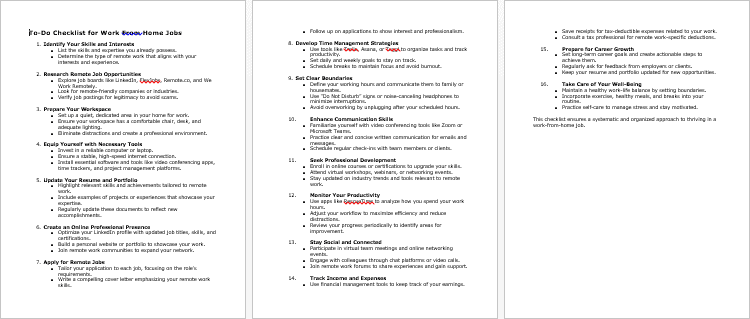
Work From Home Jobs PLR Course 31k Words
in PLR Checklists , PLR eBooks , PLR eCourses , PLR List Building Reports , Premium PLR , Premium PLR eBooks , Premium PLR Reports , Premium White Label Brandable PLR Coaching Courses , Private Label Rights Products , Work At Home PLR , Work At Home PLR EbookChoose Your Desired Option(s)
has been added to your cart!
have been added to your cart!
#workfromhome #remotejobs #onlinebusiness #plrcourse #careergrowth #homebusiness #passiveincome
Turn the remote-work boom into your next evergreen bestseller
Working from home is no longer a trend—it’s the new normal. Every month, millions of searches are made for “remote jobs,” “freelance from home,” “virtual assistant jobs,” and “work from home with no experience.” People want legitimate opportunities, step-by-step guidance, and proof-tested systems that help them get hired and perform like pros—without wasting time on scams or dead-end applications.
The Work From Home Jobs PLR Course gives you a beautifully structured, 29K-word training program that does exactly that. It walks learners from zero clarity to job-ready confidence: identifying their best-fit roles, finding real openings, crafting remote-optimized resumes and portfolios, mastering the tools, handling isolation/productivity challenges, and building a durable remote career.
As a PLR product, this is completely editable and ready to monetize. Put your name on it, add your stories or screenshots, and launch in days—not months.
Presenting…
Work From Home Jobs PLR Course 31k Words
Who this PLR is perfect for
- Bloggers and creators in the career, productivity, side-hustle, or personal finance space
- Coaches/consultants helping clients transition to remote work or flexible careers
- Course sellers and marketplaces that want an immediately publishable remote-work curriculum
- Job boards and staffing agencies who want a value-add training for candidates
- Newsletter operators needing high-quality lead magnets, mini-courses, and paid products
What makes this course sell
- Breadth + depth. Five tightly organized modules cover the entire journey—from choosing the right remote path to staying productive, resilient, and promotable.
- Action-first structure. Every module includes clear steps, practical examples, and tools so learners always know what to do next.
- Evergreen demand. Remote work is now baked into hiring strategies across tech, customer support, marketing, education, healthcare admin, and more.
- PLR flexibility. Rebrand, edit, serialize into email lessons, record as video lessons, or package with your own templates to raise perceived value.
Inside the Work From Home Jobs Course
Module 1 — Getting Started with Work From Home Opportunities
Goal: Clarity, direction, and a professional setup.
- Step 1: Identify Your Skills and Strengths
Simple ways to inventory hard/soft skills and align them with real remote roles (writing, design, VA, CS, tech support, teaching, operations, etc.). - Step 2: Research Remote Job Categories
A beginner-friendly tour of viable categories (entry-level to pro), typical duties, and what hiring managers actually look for. - Step 3: Set Up a Home Office
Practical, budget-friendly guidance on a clean, ergonomic, distraction-resistant workspace that improves focus and credibility on calls. - Step 4: Explore Freelance vs. Contract vs. Full-Time
Clarity on income stability, schedule flexibility, benefits, and how to choose the model that fits the learner’s lifestyle and goals.
Outcome: Learners end Module 1 with a shortlist of best-fit roles and a professional home setup to hit the ground running.
Module 2 — Finding Legitimate Remote Jobs
Goal: Find real opportunities fast—and stand out.
- Step 1: Search Trusted Job Boards
Where to look first (remote-only boards and reputable general boards), how to filter effectively, and what red flags to avoid. - Step 2: Customize Your Resume for Remote Roles
Translate achievements into outcomes, highlight collaboration/async skills, and surface tool proficiency (Zoom, Slack, Google Workspace, Notion, etc.). - Step 3: Check Company Career Pages
A simple research workflow to find roles not syndicated to job boards and to tailor applications to company culture. - Step 4: Leverage Social Media for Networking
Practical LinkedIn outreach, content ideas that attract recruiters, and group/community strategies that generate warm leads.
Outcome: A repeatable prospecting routine and a remote-ready resume/profile that gets replies.
Module 3 — Mastering Remote Work Tools
Goal: Operate like a seasoned remote professional.
- Step 1: Communication Platforms
Zoom, Teams, Slack—meeting etiquette, async updates, and message hygiene to look reliable and responsive. - Step 2: Project Management
Asana, Trello, Monday—task clarity, deadlines, and visibility so managers trust performance without micromanaging. - Step 3: Cloud Storage & Collaboration
Google Drive, Dropbox, OneDrive—file naming conventions, permissions, and sharing workflows that prevent bottlenecks. - Step 4: Time & Focus Systems
Toggl, RescueTime, calendar blocking, and daily/weekly review habits that help remote workers hit deadlines consistently.
Outcome: Tool confidence and professional rhythms that make managers say “yes” to promotions and repeat contracts.
Module 4 — Navigating Work From Home Challenges
Goal: Sustain momentum, sanity, and performance.
- Step 1: Combat Loneliness and Stay Social
Practical social routines, virtual co-working, and team engagement that protect mental health. - Step 2: Create a Healthy Work-Life Balance
Boundaries, shutdown rituals, and micro-break strategies that prevent burnout. - Step 3: Handle Distractions Effectively
Clear household agreements, focus aids, and environmental tweaks to keep output high. - Step 4: Seek Professional Development
A simple plan for skill stacking (courses, certifications, communities) that increases earning power over time.
Outcome: A sustainable work cadence—and the confidence to keep growing.
Module 5 — Building a Long-Term Remote Career
Goal: Progress, promotions, and predictable income.
- Step 1: Set Career Goals and Stay Motivated
Short- and long-term goal mapping, plus metrics that show progress. - Step 2: Network with Fellow Remote Workers
How to build a support system that opens doors to better roles and referrals. - Step 3: Ask for Feedback and Grow
Cadences and questions that elicit useful feedback—then turn it into visible performance wins. - Step 4: Keep Your Resume and Portfolio Updated
A monthly maintenance routine so learners are always “opportunity-ready.”
Outcome: A living career plan that compounds skills, income, and optionality.
Exactly what you get (and can resell)
- Main Course (29,436 words) – Fully structured 5-module curriculum with 20 step-by-step lessons you can publish as a course, ebook, email series, or coaching program.
- Work From Home Jobs Checklist (592 words) – A concise action list to keep learners moving and accountable.
- Work From Home Jobs FAQs (983 words) – Pre-written answers to common objections and concerns (legitimacy, tools, experience level, pay expectations, interviews, and more).
- Ready-Made Sales Page (589 words) – Upload, add your brand, and start selling immediately.
File formats: You decide. Copy/paste into your LMS, export as PDF/EPUB, load into your email platform, or turn into video scripts.
Powerful selling points to use on your product page
- Legitimate pathways only. Help your audience avoid scams and chase roles that actually hire.
- Remote-optimized assets. Resume and profile guidance tailored to distributed teams and async-first cultures.
- Clear, simple workflows. Daily/weekly routines for consistent applications, networking, and skill growth.
- Tool mastery. Learners show up job-ready on Zoom, Slack, Asana/Trello, and cloud drives.
- Real career progression. Not just “get a job”—build a flexible, resilient, long-term remote career.
Ways to use and profit from this PLR
- Sell as a self-paced course for $97–$297 on your website or course marketplace.
- Bundle with resume/cover letter templates and charge $197–$497 as a premium package.
- Deliver as a cohort workshop (4–5 live sessions) and price at $297–$997 with Q&A and feedback.
- Turn into a video course (record your screen and voiceover) to increase perceived value.
- Offer as a client onboarding resource if you run a staffing agency, VA agency, or job board.
- Create a membership: release one module per week with office hours for recurring revenue.
- Slice into email mini-courses and lead magnets to grow your list and upsell the full course.
- Flip as a turnkey site: brand the course, add a checkout, and sell the finished property.
- License to partners (without PLR pass-through) as a white-label training for their audiences.
- Upsell coaching: pair the curriculum with 1:1 resume reviews, mock interviews, or job search audits.
Fast-start launch plan
- Week 1: Add your branding, swap in your screenshots and success stories, set price/bonuses.
- Week 2: Publish the sales page, connect checkout, and schedule a 3-email launch sequence.
- Week 3: Host a free 45-minute webinar (“How to Land Legit Remote Jobs in 30 Days”) and pitch the course.
- Ongoing: Post weekly “role breakdown” blog posts and short LinkedIn/TikTok tips that link back to the sales page.
Your PLR license
You CAN:
- Edit, rebrand, and sell the content as your own.
- Convert into audio/video, ebooks, printables, or membership content.
- Use excerpts as blog posts, lead magnets, or email sequences.
- Bundle with other paid products or trainings.
You CANNOT:
- Pass PLR/reprint/resell rights to your buyers.
- Give away the complete product for free in its current form. (Excerpts/edited pieces as freebies are okay.)
- Offer 100% affiliate commissions (max 75%).
- Add the full product to an order customers already paid for without a new purchase.
Ready to launch a premium, remote-work training under your brand?
With the Work From Home Jobs PLR Course, you get a complete, high-quality curriculum that’s easy to customize, fast to publish, and built to sell. Help your audience step into flexible careers—with confidence, clarity, and a professional toolkit—while you add a reliable revenue stream to your business.
Included today:
- 29,436-word main course
- Checklist (592 words)
- FAQs (983 words)
- Ready-made sales page (589 words)
- Full PLR rights (no redistribution of PLR)
Your next step: Add your logo, drop in your stories and screenshots, choose your bonuses, and publish.
has been added to your cart!
have been added to your cart!
Here A Sample of the Work From Home Jobs PLR Course
Welcome to the “Work From Home Jobs” course! This training is designed to help you find and thrive in work-from-home opportunities. Whether you’re looking to switch careers or enhance your current job, this course will provide the tools and strategies needed to succeed remotely. Let’s dive in with a friendly, step-by-step approach that will guide you through every module.
Module 1: Getting Started with Work From Home Opportunities
Step 1: Identify Your Skills and Strengths
Before diving into the world of work-from-home opportunities, it is crucial to take a step back and reflect on your own strengths and skills. This exercise will serve as the foundation for your job search, helping you target positions that align with your natural abilities and passions. This self-reflection will allow you to choose a career path that is both enjoyable and sustainable, making the journey more fulfilling and less stressful.
Let’s break this process into actionable steps, guiding you to discover your core strengths and skills.
Step 1.1: Reflect on Your Interests and Passions
The first question to ask yourself is, “What do I enjoy doing?” Understanding your passions is key to finding work that not only matches your skills but also makes you excited to start your day.
- Make a list of your interests: Write down everything that excites you—whether it’s writing, graphic design, helping others, teaching, or managing projects. These interests will often lead you to the job roles that you will thrive in.
- Look for patterns: Once you’ve made your list, see if there are common themes or activities that appear repeatedly. Do you enjoy being creative, solving problems, or working with people? Identifying these patterns will guide you to the right career paths.
- Consider your hobbies: Sometimes, our hobbies hold the key to our skills. For instance, if you enjoy blogging, then you likely have writing skills. If you like drawing or sketching in your spare time, you might have a knack for design. Make sure to factor these into your reflection process.
By understanding what excites you, you can ensure that the jobs you apply for won’t just be financially rewarding, but also emotionally fulfilling.
Step 1.2: Assess Your Current Skills and Experience
The next step is to evaluate the skills you already have. This is about being honest with yourself and understanding your current level of expertise in various areas. Do you have technical skills like coding or web design? Are you skilled at managing projects or handling customer queries? Your skills will determine the types of remote jobs you can apply for, so it’s important to be clear on your strengths.
- List your professional skills: Think about your past work experience, whether in full-time jobs, freelance projects, or even volunteer roles. List out the skills you used, such as project management, customer service, marketing, data entry, or sales. For example, if you’ve worked as a teacher, you likely have strong communication, organization, and teaching skills. If you’ve managed a team, you may have leadership, time management, and decision-making abilities.
- Evaluate your technical proficiency: In today’s digital world, many remote jobs require proficiency in technology and software tools. Are you comfortable with using platforms like Microsoft Office Suite, Google Drive, or Slack? Do you have experience with design tools like Adobe Photoshop, Canva, or video editing software? If you have technical expertise, this can open doors to remote roles in fields like IT support, web development, or graphic design.
- Reflect on soft skills: Soft skills are just as important as technical skills, especially for remote work where communication and self-motivation are key. Think about your interpersonal skills, problem-solving abilities, and adaptability. How well do you work under pressure? Can you work independently without much supervision? These are qualities that remote employers highly value.
Step 1.3: Identify Transferable Skills
Now that you have a clearer picture of your interests and existing skills, it’s time to think about transferable skills—those that can be applied across different job roles and industries. Many remote jobs may require a different set of technical abilities, but your transferable skills will allow you to adapt and succeed in various settings.
- Communication skills: Whether it’s written or verbal, the ability to effectively communicate is essential for most remote positions. If you’ve had experience communicating with clients, coworkers, or customers in previous jobs, this is a transferable skill that can be applied to roles in customer service, marketing, content writing, and more.
- Organizational skills: Being able to organize your tasks, manage multiple projects, and prioritize deadlines is crucial in remote work. If you have experience in scheduling, managing emails, or handling paperwork, these skills are easily transferable to jobs like virtual assistant, project management, or administrative support.
- Problem-solving: The ability to troubleshoot and find solutions, especially when working independently, is highly valued in remote positions. If you’ve solved issues in previous roles or found innovative ways to improve processes, your problem-solving skills are something you can apply to remote work in roles such as customer support, tech support, or process improvement.
- Adaptability: The remote work landscape is constantly evolving. Being able to quickly learn new tools, adapt to changing tasks, or shift focus is a skill that can benefit you across a wide range of job roles. If you’ve demonstrated flexibility in your past roles, this will serve you well in remote environments.
By identifying your transferable skills, you can cast a wider net in your job search and not limit yourself to just one field or industry.
Step 1.4: Evaluate Your Learning and Growth Potential
Finally, it’s important to think about where you want to grow. The work-from-home landscape is constantly evolving, and many industries are looking for individuals who are committed to learning and improving their skill sets. Consider areas where you might want to expand your abilities, especially if you’re looking for growth in a specific remote job category.
- Identify gaps in your skills: Are there skills you want to improve or develop further? For example, if you’re interested in content creation but lack knowledge of SEO, this is an opportunity for growth. You can take online courses to gain new skills, making yourself more competitive in the job market.
- Consider future career goals: Are there remote job roles that you see yourself growing into in the future? For example, you might start as a content writer but aim to move into a content management position later on. Identifying these long-term goals will help you understand the skills you need to acquire today to reach your desired position.
- Stay current with trends: Remote work is highly influenced by technology. Staying updated on the latest trends in remote work tools, digital marketing, project management, and other relevant fields can make you more adaptable and valuable as a remote worker.
By recognizing where you want to grow, you ensure that you’re not just taking a job that fits your current skills but one that also sets you up for future success.
Conclusion
Taking the time to identify your skills and strengths is the first and most important step in your journey to securing a work-from-home job. Reflect on your interests, assess your current skills, identify your transferable abilities, and evaluate your potential for growth. Doing so will allow you to target the right remote jobs that align with your abilities, passions, and career goals. With this clarity, you can confidently move forward in your search for the perfect work-from-home opportunity.
Step 2: Research Remote Job Categories
Once you have a clear understanding of your skills, strengths, and interests, it’s time to take the next crucial step in your work-from-home job search: researching remote job categories. The world of remote work is vast, and there are many different job categories you can explore. From customer service and virtual assistants to tech support and writing, each sector offers a wide range of opportunities. The goal of this step is to help you explore these various sectors to understand where you might fit in and identify job roles that match your strengths and passions.
This step involves diving into the world of remote work and understanding what each job category entails. You’ll explore the responsibilities, required skills, and potential growth areas of each sector to make an informed decision about which remote job category is the best fit for you.
Let’s break down this process into actionable steps to help you research and assess the most suitable remote job categories for you.
Step 2.1: Explore Popular Remote Job Categories
The first thing you need to do is familiarize yourself with the different job categories available in the remote work world. Each category offers unique opportunities, and it’s important to explore a variety of them to see where you might thrive.
- Virtual Assistants: Virtual assistants (VAs) support businesses or individuals by handling administrative tasks such as scheduling, email management, customer support, and data entry. If you have strong organizational and communication skills, this might be a good fit for you. VAs often work with small businesses, entrepreneurs, or busy executives who need help managing their daily operations.
- Writers and Content Creators: Writers, bloggers, copywriters, and content creators are in demand in many industries. If you enjoy writing and have a flair for creating compelling content, this might be your calling. Content creation is crucial for digital marketing, blogs, websites, and social media platforms, and it’s a flexible field that allows you to choose from different writing niches, such as technical writing, SEO writing, creative writing, or even scriptwriting.
- Data Entry: Data entry jobs involve inputting, organizing, and managing data. These roles require attention to detail and can often be done on a flexible schedule. If you enjoy working with numbers or spreadsheets and have good typing speed, data entry could be a straightforward option.
- Customer Service: Many companies are outsourcing their customer service teams to work remotely. If you have strong communication skills and enjoy helping people solve problems, remote customer service roles may be ideal. These positions typically involve handling customer inquiries, troubleshooting issues, and managing support tickets via phone, email, or chat.
- Tech Support: Tech support professionals provide assistance to customers or businesses facing technical issues. These jobs require a strong understanding of computers, software, or specific technical systems. If you have technical expertise and enjoy problem-solving, this is a highly in-demand field in the remote job market.
- Social Media Managers: Social media managers oversee a company’s social media presence by creating content, engaging with followers, and developing marketing strategies. If you are passionate about social media and have experience managing accounts or creating content, this could be an exciting career path.
- Transcription and Translation Services: If you have strong listening skills and attention to detail, transcription might be a good fit. Alternatively, if you are bilingual or multilingual, offering translation services for written or spoken content can also be a valuable skill in the remote job market.
By exploring these popular remote job categories, you’ll get a better understanding of the diversity within remote work and where your interests and skills might align.
Step 2.2: Identify Required Skills for Each Category
Each remote job category requires a specific set of skills, and it’s important to match your existing skills with those required for each field. This step will help you evaluate if you need additional training or if you already have the necessary skills to enter a particular category.
- Virtual Assistant Skills: As a VA, you’ll need strong organizational, communication, and multitasking skills. You should be comfortable using office software like Microsoft Office, Google Workspace, and project management tools such as Trello, Asana, or Slack. Many VAs also need basic knowledge of social media platforms, CRM tools, and email marketing tools.
- Writing and Content Creation Skills: To succeed as a writer, you need excellent writing and grammar skills. Understanding SEO (search engine optimization) is an added advantage if you plan to write for blogs or websites. Additionally, the ability to conduct thorough research and meet deadlines is crucial. For content creation, knowledge of multimedia platforms (e.g., YouTube, podcasts) can be beneficial.
- Data Entry Skills: Data entry jobs require fast and accurate typing skills, attention to detail, and familiarity with data management software like Microsoft Excel, Google Sheets, and other database management tools. An ability to organize and clean data is essential.
- Customer Service Skills: For remote customer service roles, strong communication skills (both written and verbal) are essential. Being empathetic and patient is a must since you’ll often deal with frustrated customers. Familiarity with customer support tools (Zendesk, Freshdesk, etc.) and the ability to manage multiple queries at once will set you apart.
- Tech Support Skills: Tech support roles require deep technical knowledge, such as troubleshooting hardware or software issues, understanding networking concepts, and familiarity with various operating systems. Patience and clear communication are important to guide customers through solving technical problems.
- Social Media Management Skills: As a social media manager, you need to know how to create engaging content for different platforms (Instagram, Facebook, Twitter, LinkedIn, etc.). Understanding analytics, content scheduling tools, and digital marketing strategies (e.g., SEO, PPC) is also beneficial. Creativity and understanding of the target audience are key to success.
- Transcription and Translation Skills: For transcription, fast and accurate typing, great listening skills, and attention to detail are critical. In translation, fluency in more than one language and an understanding of cultural context are essential.
By reviewing the required skills for each category, you can assess which roles best match your existing expertise and where you might need to invest in learning new skills.
Step 2.3: Understand the Job Market and Demand
Once you have a general understanding of remote job categories and their required skills, it’s essential to understand the demand for each type of job. Certain remote job categories are more competitive or have a higher volume of job openings, while others might offer more specialized opportunities that require unique expertise.
- Research job boards and websites: Platforms like LinkedIn, Indeed, Remote.co, FlexJobs, and We Work Remotely will give you insights into the current demand for various remote job categories. Take note of how many job listings are available in each category and how frequently new positions are posted.
- Explore industry trends: Certain sectors, such as customer service, content writing, and tech support, are experiencing a higher demand for remote workers due to the rise of digital businesses. On the other hand, specialized roles such as transcription or translation may have fewer openings but higher competition.
- Consider job longevity and growth: Some remote job categories may have better long-term growth potential than others. For example, digital marketing, content creation, and tech support are likely to expand as more companies go online. Conversely, roles in traditional industries may see fluctuations in demand as automation or outsourcing impacts job availability.
By researching the job market, you’ll better understand which remote job categories offer the most opportunities and which ones are experiencing growth.
Step 2.4: Test the Waters with Freelance or Part-Time Jobs
Before committing fully to a particular remote job category, it’s wise to test the waters by starting with freelance or part-time opportunities. This allows you to gain hands-on experience in a specific category without committing to a full-time position right away. You’ll get a clearer sense of whether the job aligns with your skills, interests, and expectations.
- Start small: Explore freelance platforms like Upwork, Fiverr, or Freelancer to find short-term or small projects within your chosen job category. For example, if you’re interested in writing, take on a few writing gigs to get a feel for the industry. If you’re considering a career in tech support, you could start with a few customer support tickets or help desk projects.
- Build your portfolio: If you’re working in a category like writing, design, or social media management, it’s crucial to start building a portfolio. Showcasing past work—whether from freelance gigs or personal projects—will make you more attractive to potential clients or employers.
- Evaluate your satisfaction: As you start taking on small jobs, reflect on how well they align with your passions and interests. Do you enjoy the work? Are you good at it? Do you find the tasks fulfilling? This evaluation will help you determine if this remote job category is a long-term fit.
By starting with freelance or part-time jobs, you can explore different categories without fully committing, helping you make an informed decision before transitioning to a full-time remote career.
Conclusion
Researching remote job categories is a vital step in your work-from-home journey. By exploring different sectors, understanding the skills required, analyzing job demand, and testing roles with freelance work, you’ll be able to pinpoint which category best suits your abilities, interests, and career goals. This research will empower you to make an informed decision about your future in remote work and ensure that you’re heading in the right direction toward a fulfilling and successful career.
Step 3: Set Up a Home Office
Setting up a productive and comfortable home office is a critical step in ensuring your success in remote work. While the freedom to work from home is a significant advantage, it also comes with challenges—mainly the need to create an environment conducive to productivity. A dedicated workspace helps minimize distractions, enhances focus, and supports your well-being, especially if you’re working long hours.
In this step, we will guide you through setting up a home office that fosters productivity, creativity, and comfort. Whether you’re a course creator, freelancer, or full-time remote worker, the following steps will help you design a space that enhances your ability to work efficiently and comfortably.
Step 3.1: Choose the Right Location
The first task in setting up your home office is selecting the right location. It’s essential to pick a space that minimizes distractions and allows you to focus. While it may seem tempting to work from the couch or bed, these spaces are not ideal for long-term productivity.
- Find a quiet area: Look for a room or corner in your home that is free from high traffic and noise. If possible, select a location that’s separate from other areas where people gather, like the living room or kitchen. A quiet environment helps you stay focused, reduces distractions, and allows you to concentrate fully on your tasks.
- Consider natural light: Choose a space that offers adequate natural lighting. Natural light has been shown to improve mood and productivity. If the room lacks natural light, you may need to invest in good artificial lighting. Lighting is crucial to reduce eye strain and maintain energy levels.
- Ergonomically suitable location: Make sure the space you choose is large enough for all your equipment, such as a desk, computer, and other tools. It should also allow you to maintain proper posture during work to prevent back or neck strain. If the room is too small or cramped, it could lead to discomfort during long work hours.
- Personalize your space: While functionality is key, personalizing your workspace can help you feel more comfortable and motivated. Consider adding personal touches like artwork, plants, or motivational quotes that inspire you and make your workspace feel like your own.
Step 3.2: Invest in the Right Tools
To perform your work efficiently and without frustration, you need the right tools. Investing in quality equipment will not only improve your productivity but also reduce the risk of injuries like back or eye strain that can occur from using poor-quality gear.
- Computer and Software: A reliable computer is essential. Depending on your work, you may need a laptop or desktop. If your work involves resource-intensive tasks such as video editing, graphic design, or data analysis, opt for a high-performance computer. Additionally, ensure your computer is up to date and has the required software for your tasks, such as office productivity tools (Microsoft Office, Google Workspace), design programs (Adobe Suite), or course creation software.
- Internet Connection: A stable and fast internet connection is a must-have for remote work. Slow or unreliable internet can disrupt video calls, cloud-based work, and even communication with clients or team members. Check your internet speed to ensure it’s sufficient for your work demands. A wired connection (Ethernet) is generally more reliable than Wi-Fi, but if you must rely on Wi-Fi, invest in a high-quality router and ensure your signal strength is optimal in your workspace.
- Ergonomic Furniture: Since you’ll likely be spending many hours at your desk, ergonomic furniture is crucial for comfort and long-term health. Invest in an ergonomic chair that supports proper posture, particularly the lower back, and promotes a natural alignment of your spine. Your desk should be at the right height to avoid strain on your wrists and elbows. Adjustable desks that allow you to switch between sitting and standing are a great option for improving comfort.
- Keyboard, Mouse, and Other Accessories: Choose comfortable and responsive peripherals that suit your typing style. If you spend a lot of time typing, consider investing in an ergonomic keyboard and mouse to reduce wrist strain. A mouse pad with wrist support can also help. Additionally, using a monitor rather than just relying on a laptop screen can reduce eye strain and improve posture.
- Noise-canceling Headphones: If you’re working in a noisy environment or need to attend virtual meetings, noise-canceling headphones can significantly improve your focus and ensure you don’t miss out on important conversations.
Step 3.3: Optimize Your Workspace for Productivity
Now that you have the right tools in place, the next step is to optimize your workspace for productivity. A well-organized and thoughtfully arranged workspace can enhance your efficiency, creativity, and overall work experience.
- Declutter your desk: A cluttered workspace can lead to stress and reduce your focus. Keep only essential items on your desk to minimize distractions. Organize your desk with drawer organizers, file holders, and desktop organizers to store papers, tools, and other materials neatly.
- Use cable management: Tidy up your cables to avoid clutter and potential accidents. Use cable organizers, clips, or cable ties to keep cables out of sight and neatly arranged. This will not only make your space look clean but also reduce distractions.
- Create zones for different tasks: If your work requires you to switch between different tasks, like creating content, attending meetings, or doing research, consider setting up different zones within your workspace. For example, you can have a dedicated desk for content creation, a comfortable chair for reading and research, and a clean area for virtual meetings. Having clear distinctions between tasks can help you stay mentally organized and focused.
- Keep necessary supplies within reach: Having basic office supplies like pens, notebooks, sticky notes, and a printer in close proximity will prevent you from having to leave your workspace for every small task. However, try not to overcrowd your desk with too many items, as this can lead to distraction.
Step 3.4: Focus on Health and Well-being
Since working from home can sometimes blur the lines between personal and professional life, maintaining a focus on health and well-being is essential for long-term success. This includes creating an ergonomic setup, practicing good posture, and incorporating regular breaks into your routine.
- Invest in ergonomic seating and posture tools: A comfortable chair is key, but adding ergonomic accessories, such as a lumbar support cushion for your lower back or a footrest, can enhance comfort further. Proper alignment of your body will help prevent neck, back, and wrist pain, especially if you are sitting for long periods.
- Stay active: Sitting for extended hours can lead to physical discomfort and decreased productivity. Integrate short, regular breaks into your schedule, during which you can stand up, stretch, or take a short walk. You might also want to invest in a standing desk or a desk converter that lets you alternate between sitting and standing throughout the day.
- Adjust lighting for comfort: As mentioned earlier, good lighting is crucial, but you should also adjust it to prevent eye strain. If you’re working at a computer for long hours, consider using adjustable desk lamps with warm, soft lighting to reduce glare on your screen. Keep in mind that blue light from screens can disrupt your sleep, so using blue light-blocking glasses or enabling blue light filters on your devices can protect your eyes and improve your sleep quality.
- Maintain mental well-being: Creating a work environment that supports your mental health is just as important as your physical space. Ensure that your home office has elements that inspire and calm you, whether it’s a personal picture, a plant, or a favorite piece of artwork. Taking breaks for relaxation, practicing mindfulness, and maintaining a work-life balance are key for sustained focus and productivity.
Conclusion
Setting up a home office is not just about finding a desk and a computer. It’s about creating an environment that nurtures your productivity, health, and well-being. By selecting the right location, investing in quality equipment, optimizing your workspace for focus, and prioritizing your physical and mental health, you’ll be well-equipped to thrive in your remote work journey. Remember, your home office is more than just a workspace—it’s a space where you can build a routine, stay focused, and be at your most productive.
Step 4: Explore Freelance and Full-Time Remote Options
Once you have a clear understanding of your skills, strengths, and the right home office setup, it’s time to explore the diverse types of remote work available to you. This is a crucial step in your journey, as understanding the various work-from-home job options will help you decide which path aligns with your professional goals, personal preferences, and lifestyle.
Remote work can be categorized mainly into freelancing, contract work, and full-time remote jobs, each with its own set of advantages and challenges. Some remote workers enjoy the freedom and flexibility of freelancing, while others prefer the stability and benefits that come with full-time positions. In this section, we will explore these options in detail, helping you choose the right fit for you.
Step 4.1: Freelancing – Embrace Flexibility
Freelancing is one of the most popular ways to work remotely, offering a high degree of flexibility and autonomy. As a freelancer, you essentially become your own boss—choosing which clients to work with, when to work, and how much work to take on. This is an ideal option for those who prefer variety, independence, and a dynamic work schedule.
Here’s a step-by-step guide to understanding freelancing as a work-from-home option:
- Determine your niche: As a freelancer, you have the freedom to choose the types of projects and industries you want to focus on. However, to stand out and attract the right clients, it’s essential to carve out a niche for yourself. For example, if you are a writer, you could specialize in blog posts, e-books, or academic writing. Similarly, a graphic designer might focus on branding, social media design, or website visuals. The more specialized your skillset, the easier it will be to position yourself as an expert in that area.
- Build a strong portfolio: A solid portfolio is your key to attracting clients and building a reputation as a reliable freelancer. Showcase your best work, emphasizing quality over quantity. You can start by creating sample projects if you don’t have client work to display yet. Freelancers with a well-organized and compelling portfolio are more likely to be hired for high-paying gigs.
- Search for freelance platforms: There are numerous online platforms where you can find freelance opportunities, including Upwork, Fiverr, Freelancer, and Toptal. These platforms allow you to browse job listings, submit proposals, and negotiate terms with clients. While these platforms can be highly competitive, they also provide access to a global client base and various opportunities. Make sure to choose the platforms that align best with your skills and professional goals.
- Set your rates and terms: One of the advantages of freelancing is that you can set your own rates. However, it’s crucial to be realistic about how much to charge. Research what other freelancers in your field are charging and adjust your rates based on your experience, skill level, and the market demand. Be clear about your terms, including deadlines, payment schedules, and revisions, to avoid misunderstandings with clients.
- Maintain a healthy work-life balance: Freelancing offers freedom, but with that freedom comes the responsibility to manage your time effectively. Without the structure of a traditional office job, it’s easy to fall into the trap of overworking or struggling to manage deadlines. Create a consistent work schedule that allows you to meet client deadlines while also maintaining personal time.
Step 4.2: Contract Work – A Middle Ground
Contract work combines elements of freelancing and full-time employment, offering more stability than freelancing but less commitment than a traditional full-time role. As a contractor, you’ll typically be hired for a specific project or time period, but you may have the flexibility to negotiate working hours and job expectations.
Here’s a detailed guide on contract work:
- Contract length and terms: Contract positions can vary in length—from a few weeks to several months or even years. While they may not offer the long-term stability of a full-time role, they do provide a steady stream of income for a defined period. Be sure to clarify the terms of the contract, such as project scope, duration, deliverables, and payment schedule, before signing any agreements.
- Job benefits: Unlike full-time employees, contractors may not receive benefits such as health insurance, retirement plans, or paid leave. However, some companies may offer benefits for contractors working for a certain number of hours or months. It’s crucial to weigh the potential earnings from a contract role against the lack of additional benefits.
- Work environment and collaboration: Contract workers often collaborate with in-house teams or other contractors, allowing for more integration into the company culture than freelancers might experience. Contractors may be required to attend virtual meetings, share progress updates, and contribute to group projects, making it a good option for individuals who prefer team-based environments.
- Long-term opportunities: While contract work is temporary, it can open doors to future full-time opportunities. Many companies use contract roles as a trial period to evaluate potential full-time hires. If you excel in a contract position, it could lead to a permanent role, giving you both the flexibility and security of a full-time position.
Step 4.3: Full-Time Remote Jobs – Stability and Security
A full-time remote job is essentially a traditional job that you perform from the comfort of your home. Full-time remote workers are typically employees of companies and enjoy a structured schedule, job security, and benefits such as paid time off, healthcare, and retirement plans. This option may appeal to individuals who prefer stability and don’t want to deal with the uncertainty of finding new clients or managing their own business.
Here’s how to navigate full-time remote job options:
- Job stability and benefits: One of the biggest advantages of full-time remote work is stability. As a full-time employee, you can count on a consistent income, job security, and benefits like health insurance, retirement plans, and paid leave. For many people, these benefits outweigh the flexibility offered by freelancing or contract work.
- Company culture and communication: Remote work for a company often requires strong communication skills and the ability to adapt to virtual team environments. You may have to attend regular meetings, collaborate with team members via email or video calls, and contribute to projects that align with company goals. Full-time remote jobs can help you build connections with colleagues and stay integrated into the company’s culture, even though you’re working from home.
- Clear structure and expectations: Full-time remote jobs generally come with clear expectations, including fixed working hours, a defined role, and specific tasks. For some, this structure can help prevent the distractions that come with freelancing, making it an excellent option for those who prefer routine and defined responsibilities.
- Search for remote job listings: To find full-time remote work, you can use traditional job boards (like LinkedIn, Indeed, and Glassdoor) or specialized remote job boards such as We Work Remotely, Remote.co, and FlexJobs. These platforms feature job listings from companies looking for remote employees in various industries. Make sure to tailor your resume and cover letter for remote positions to highlight your ability to work independently, communicate effectively, and use remote work tools.
- Evaluate the employer’s remote culture: Not all companies are well-equipped for remote work. When applying for a full-time remote position, research the company’s approach to remote work. Look for companies that offer a supportive remote culture, have a history of remote employees, and provide the tools and resources necessary for success in a remote work environment.
Step 4.4: Choosing the Right Path for Your Lifestyle
Choosing between freelancing, contract work, and full-time remote employment depends largely on your personal lifestyle, career goals, and work preferences. Here’s how to evaluate which option might be the best fit for you:
- Consider your financial goals: Freelancing and contract work often come with more variable income, as they depend on the number of clients or contracts you secure. If you prefer a stable and predictable paycheck, a full-time remote job might be the best choice. Conversely, if you want the opportunity to earn more or choose your own work schedule, freelancing could be a better fit.
- Evaluate work-life balance: Freelancing offers flexibility but also demands a high degree of self-discipline to manage time effectively. Full-time remote jobs offer a more structured work-life balance with clear working hours, but they may require more consistent availability for meetings or deadlines. Think about how much flexibility you need in your schedule.
- Consider long-term stability vs. independence: Full-time remote jobs offer long-term stability, while freelancing gives you more independence and variety. If you’re looking to grow professionally within a company, a full-time job may provide more opportunities for career advancement. If you value independence and enjoy the freedom to pick your own clients and projects, freelancing might be more appealing.
- Your skill set and work preferences: If you have a niche skill set or specialized expertise, freelancing or contract work might allow you to focus on projects that align with your passions and abilities. Full-time roles, on the other hand, may provide more opportunities for professional development and career growth within a larger company.
Conclusion
Exploring the various remote work options—freelancing, contract work, or full-time remote jobs—provides you with the flexibility to choose a career path that best aligns with your skills, lifestyle, and work preferences. Each option has its unique set of advantages and challenges, so it’s essential to weigh them carefully before making a decision. By understanding the different paths, you can make an informed choice that helps you thrive in your work-from-home journey.
We’re also giving these extra bonuses
Work From Home Jobs – Checklist

Work From Home Jobs – FAQs

Work From Home Jobs – Salespage Content

Package Details:
Word Count: 29 436 Words
Number of Pages: 102
Work From Home Jobs – Bonus Content
Checklist
Word Count: 592 words
FAQs
Word Count: 983 words
Salespage Content
Word Count: 589 words
Total Word Count: 31 600 Words
Your PLR License Terms
PERMISSIONS: What Can You Do With These Materials?
Sell the content basically as it is (with some minor tweaks to make it “yours”).
If you are going to claim copyright to anything created with this content, then you must substantially change at 75% of the content to distinguish yourself from other licensees.
Break up the content into small portions to sell as individual reports for $10-$20 each.
Bundle the content with other existing content to create larger products for $47-$97 each.
Setup your own membership site with the content and generate monthly residual payments!
Take the content and convert it into a multiple-week “eclass” that you charge $297-$497 to access!
Use the content to create a “physical” product that you sell for premium prices!
Convert it to audios, videos, membership site content and more.
Excerpt and / or edit portions of the content to give away for free as blog posts, reports, etc. to use as lead magnets, incentives and more!
Create your own original product from it, set it up at a site and “flip” the site for megabucks!
RESTRICTIONS: What Can’t You Do With These Materials?
To protect the value of these products, you may not pass on the rights to your customers. This means that your customers may not have PLR rights or reprint / resell rights passed on to them.
You may not pass on any kind of licensing (PLR, reprint / resell, etc.) to ANY offer created from ANY PORTION OF this content that would allow additional people to sell or give away any portion of the content contained in this package.
You may not offer 100% commission to affiliates selling your version / copy of this product. The maximum affiliate commission you may pay out for offers created that include parts of this content is 75%.
You are not permitted to give the complete materials away in their current state for free – they must be sold. They must be excerpted and / or edited to be given away, unless otherwise noted. Example: You ARE permitted to excerpt portions of content for blog posts, lead magnets, etc.
You may not add this content to any part of an existing customer order that would not require them to make an additional purchase. (IE You cannot add it to a package, membership site, etc. that customers have ALREADY paid for.)
Share Now!











